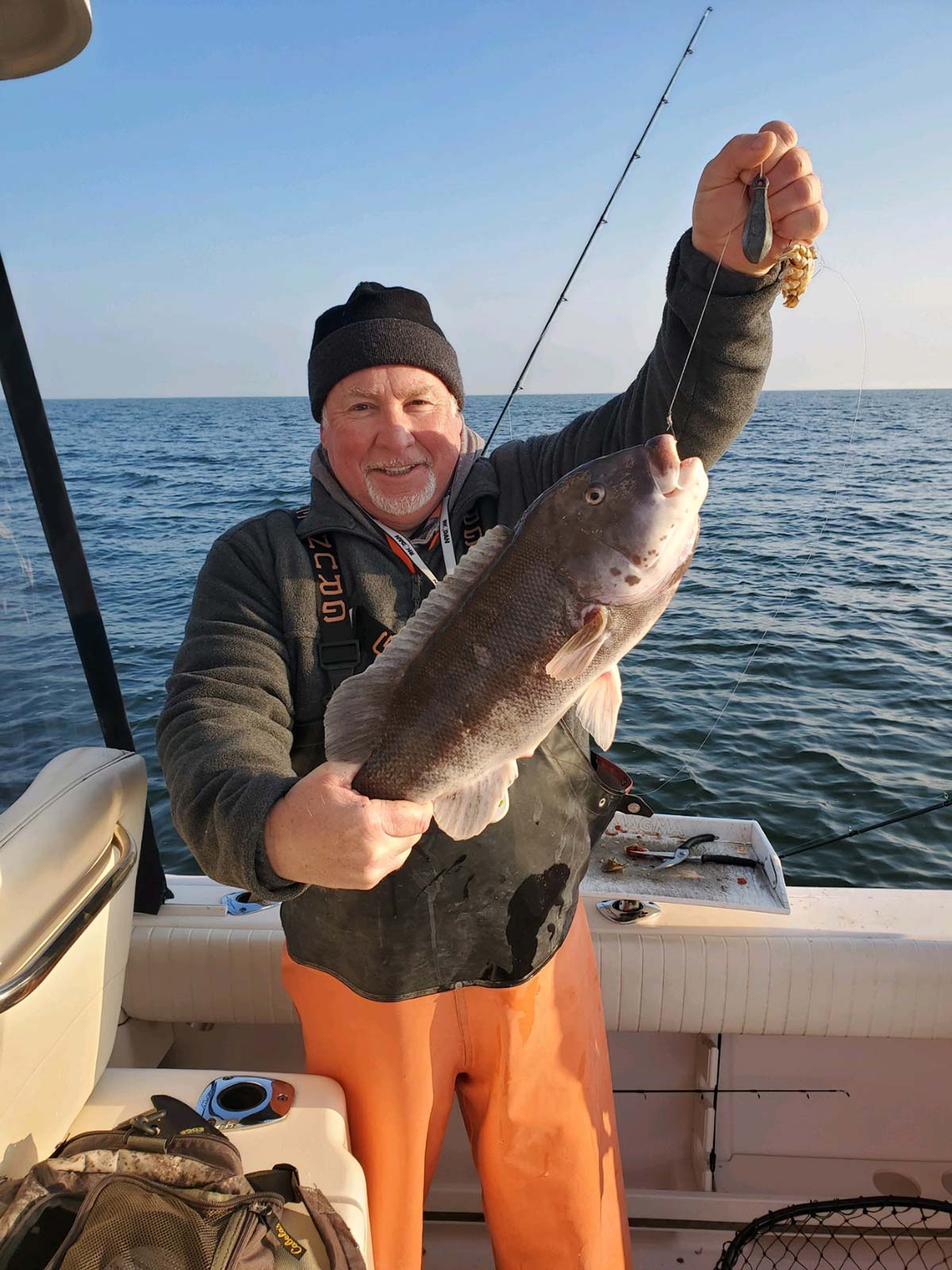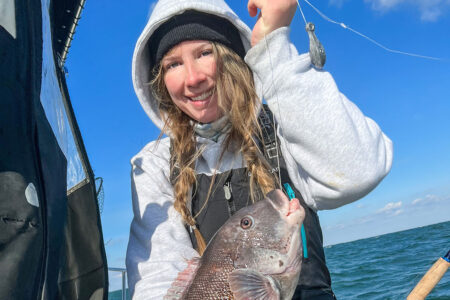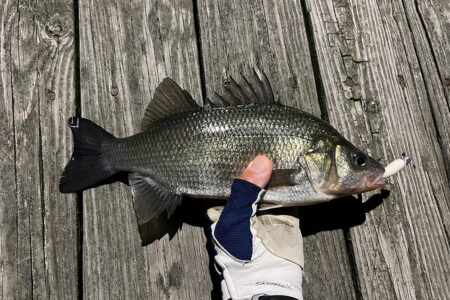
The trolling motor is changing the way we wreck fish.
As a youngster growing up on Long Island and trying to learn about saltwater fishing, I was most in awe of anglers specializing in blackfish. Not only do those fish feed differently from other fish and are difficult to hook, but they live on wrecks and rough bottoms that could only be located by running precise time and course before lining up shore ranges; sometimes by feeling bottom with a lead line before anchoring on a spot that might end up claiming an expensive anchor.
There was no Fisherman magazine in those days that a novice could refer to for even the basics of the sport. It was also well before small boat electronics became a game-changer for all types of saltwater boat fishing. Yet, even then there was the necessity of anchoring properly in order to catch blackfish consistently. Only on calm days will a single anchor keep a boat situated on a small piece. And blackfish specialists almost invariably use two anchors to lock-in on their spots while providing the means to make corrections as winds and currents change.
But the blackfishing world has changed with the advent of modern saltwater electric motors in combination with GPS, auto pilot and fishfinder. It’s not cheap to install the system, but it’s been another game-changer on both small and large boats which allows even those who never had the “feel” for blackfishing to score regularly.
Capt. Joe Massa had a Rhodan system installed on his 30-foot Grady White My Three Sons last summer. Though Massa doesn’t charter, he’s long been a top notch blackfisherman, and was anxious to show me how the system makes his favorite sport more fun by not having to anchor. During the trip in early October we were accompanied by his friend Dan Rubino and Capt. Vinny Vetere on a busman’s holiday from his Great Kills, Staten Island charter boat Katfish. We headed to Breezy Point for a shot at the big porgies that had been there. Upon arriving at his spot, Massa took the electric motor out of its cradle in the bow and set it up within minutes.
Our lines went straight to bottom, and I quickly put scup of 16 and 17 inches in the live well. Those were among the largest I’d seen inshore in NY/NJ Bight since the 1950s when a burlap bag could be loaded with “sea porgies” from a rented skiff out of Stella Maris in Sheepshead Bay by dropping an anchor on the Tin Can Grounds. Those porgies hit green crab-baited hooks while, surprisingly, Vetere was catching only tiny sea bass on clam. Blackfish then took over, but were out of season in New York waters. Massa made a quick run south to Shrewsbury Rocks where the one per man summer season was still in effect.
Capt. Robert Taylor uses the Humminbird Solix 15 Chirp MSI+ G3 aboard his NSF Charters, along with the Minn Kota Riptide Terrova 112-pound thrust trolling motor with 87-inch shaft. The i-Pilot Link Integrated GPS Trolling System links the Terrova with the Solix, which allows control of the trolling motor from Link’s color touch-screen remote or the Humminbird. Capt. Taylor is able to set Spot-Locks, record paths, follow depth contours, automatically navigate to his favorite spots, and control speed and steering, and more. Find more product information at Minnkotamotors.com.
It was breezy, but once again our blackfish jigs went straight down as the electric motor kept us perfectly situated on the spot. Massa was able to fish while making slight corrections with the remote. Not only did that result in steady action, but we weren’t losing jigs as we were almost always able to pull off snags by being directly over them. When the bite slowed, Massa used the remote to move all around the piece to determine if he’d missed anything. Best of all, when we were ready to leave, it was just a matter of turning on the outboards and heading home after asking a friend fishing near us what that rope hanging off his bow was all about!
We didn’t have to deal with rough seas that day, and that can be a problem as the electric motor’s propeller must be underwater. If you want to fish in rough seas, there are means of overcoming the problem. Massa deploys his anchor to reduce the effect of the larger waves.
A Captain’s Friend

Capt. Robert Taylor of NSF Charters in Newport, RI finds that by barely moving his 30-foot downeaster ahead with the trolling valve, his Minn Kota prop stays underwater and he’s able to fish on even tiny spots. While running striper charters, Taylor is also scanning bottom for any underwater rock or rough bottom he can save on GPS to try during tautog season. Those small spots would be too frustrating and time consuming to anchor on properly, but with the new system, GPS will take him right back to drop baits and see if anyone’s home with hardly any time lost in the effort.
Selecting the proper shaft length for the boat is the first consideration. Many charter skippers are using Minn Kota electric motors as that company has long been established in the business and backs up their use in tough saltwater conditions that they weren’t originally intended for. Capt. Jessie Bloomquist of Flat Out Fishin’ noted that one of the best things about his Minn Kota is the ability to quickly move from wreck to wreck and cover many in a day’s fishing when necessary. He also doesn’t drift for fluke any longer. By hovering over his spots around structure his customers can jig right on the prime bottom until it’s time to move on. He finds that fluke of a certain size tend to group together, and larger ones may be only yards away.
Capt. Brett Taylor is another skipper so sold on the Minn Kota’s he has them on both his large and small Reel Reaction boats that he has spares for both so as not to lose a day without them during charter season even though the only problem was his own fault by hitting bottom on the bay; and Minn Kota still honored the warranty.
Capt. Nino Aversa trailers his 23-foot Parker with the Minn Kota Ulterra to the best blackfish and fluke fishing in the region, and fishes many contests. He emphasizes the safety factor as powering over a wreck is far more comfortable for family groups and seniors than fishing at anchor in a choppy sea.

The Bottom Line
It’s a new world of blackfishing now and any boater who can afford the electronics and electric motor rigging should be able to do quite well with the wary tautog. Most of the charter skippers I talked to were skilled enough to do the installation themselves. However, that may not be in the cards for most boaters, and it’s vital to get all the components working together. That’s especially the case with the bracket which takes a pounding on the bow. You’ll also need a dedicated bank of the best heavy duty batteries which will handle at least a full day of fishing before recharging.

Tyson Alvanos of Minn Kota says their large boat 87-inch Terrova with an 87-inch shaft has a list price of $2,999. Installation varies greatly depending on fabrication of custom brackets. Figure on anywhere from $800 to $3,000. As previously noted, it’s not cheap, but it’s been such a game-changing difference that several captains told me that they are worried about the effect this technology will have on blackfish stocks as relative newcomers are able successfully fish bottoms that had been too difficult for their anchoring skills.
Fortunately, we do have strict regulations now, and blackfish are one of the most prolific bottom fish, albeit slow growing. The population held up well despite heavy angling pressure when there were no limits, but tautog had virtually no market value then. It wasn’t until Asian restaurants started featuring them as live fish that they became valuable and the object of intense commercial fishing that’s still being carried on both legally and illegally. To address the pervasive issue of illegal harvest of undersized and unreported tautog, the Atlantic States Marine Fisheries Commission established a commercial harvest tagging program. Under the tagging program, commercial fishermen are required (as of 2020) to tag all tautog at the time of harvest or prior to offloading. Tautog tags are non-lethal and will be applied to fish intended for both live and fresh markets.
One noticeable change on the recreational side has been the evolution in the sport as trophy-size blackfish are more often now measured or weighed on hand scales before being released — especially in the case of females obviously loaded with roe. That would have been unheard of when I was a youngster at a time when there were no regulations at all on tautog.
Tautog (Blackfish): 16″ minimum size
LI Sound: April 1-30, 2 fish / October 11 – December 9, 3 fish
NY Bight: April 1-30, 2 fish / October 15 – December 22, 4 fish
Needless to say, there are many other uses for electric motor fishing. No-drift fluke trips are no problem, sea bass wrecks can be quickly sampled to find the right one, and bump-trolling live baits won’t require going in-and-out of gear to maintain very slow movement. Capt. Taylor even uses the system when giant tuna fishing as it allows him to add rods in the bow which have produced for him.
Within a few years I expect that boats sporting electric motors will be a common sight both inshore and offshore.


